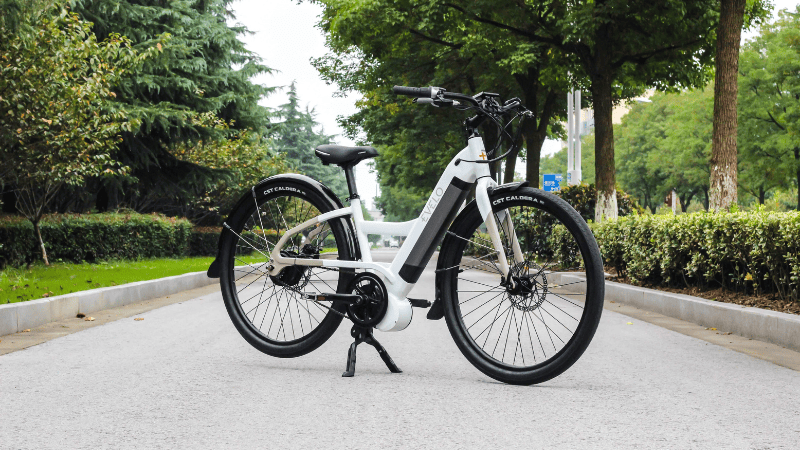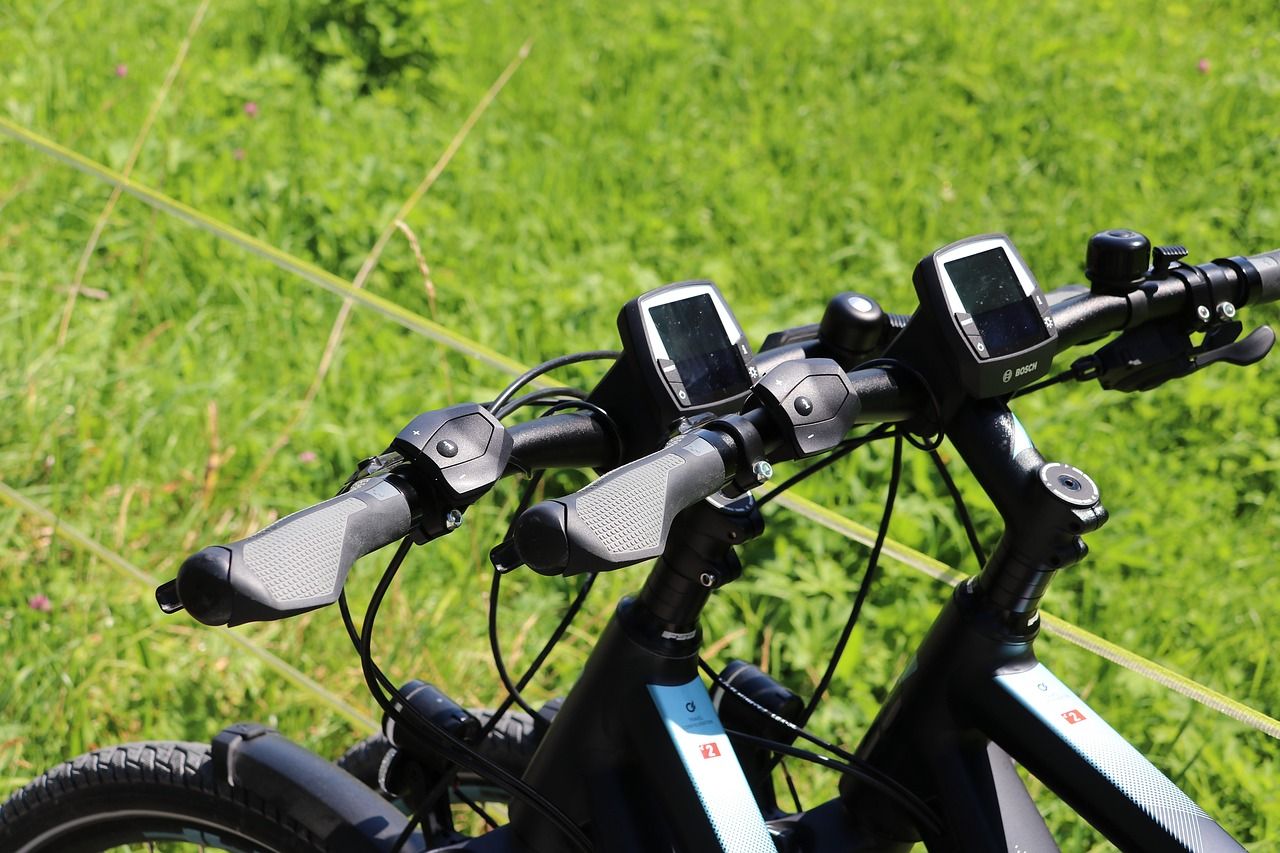Unlike traditional bikes, e-bikes are excellent for the assistance they offer to your pedalling efforts. The driving force behind that power assistance is the motor, and there are two types; the hub drive and mid-drive motors. Both have the same function but are often ideal in certain unique use cases.
So, if you're considering getting a new e-bike, it's important to understand which is ideal. The motor type has a profound effect on the performance of your e-bike and even the price. Read on to learn how they differ and impact the bike’s performance.
What are Hub Drive Motors?

A hub motor gets its name from where it is located on your e-bike. They are found in either the front or rear wheels. This type of motor is the most common, and there are two main types: geared and gearless. Geared hub motors use a set of gears to increase the torque and speed of the motor, while gearless hub motors use a magnetic field to turn the wheel directly.
In the context of electric motors, torque refers to the amount of rotational force the motor can produce to turn a wheel or other mechanical component. The greater the torque, the greater the force the motor can apply to move the object it is driving.
Both types of hub drive motors are simple, efficient, and require very little maintenance. They are also best suited for flat terrains since they produce less torque. When in operation, the motor's level of assistance can usually be controlled through a handlebar-mounted display. The motor can also be programmed to provide assistance automatically based on the pedalling speed and power output.
But that's not to say they are without drawbacks. The first is their weight which negatively impacts the rotation of the wheel. It makes bike handling hard and, sometimes, difficult to change tires. Also, hub motors are less efficient due to the far distance it has to your pedalling point. There is also the issue of the motor limiting your wheel components like rims and cassettes.
The rider starts by pedalling the bike or activating the throttle, which sends a signal to the motor controller. The motor controller then sends a current to the hub motor, which starts spinning. The spinning motion of the motor turns a series of gears, converts the rotational energy into torque, and transmits it to the bike's wheel, causing it to rotate.
As the wheel rotates, it propels the bike forward, providing the rider with assistance in pedaling or completely propelling the bike via the throttle. The hub drive uses a simple mechanism that converts electrical energy into rotational motion to move the bike forward.
Pros of Hub Drive Motors
- Simple design
- Low maintenance
- Quieter operation
- Good for flat terrain
Cons of Hub Drive Motors
- Limited torque
- Can be heavy and affect handling
- More difficult to repair or replace
What are Mid Drive Motors?

A mid-drive motor is located somewhere in the middle of your bike. It is mounted on the e-bike frame and connected to the pedal chains or belt. This design helps maintain a consistent power supply since it quickly senses the pedalling efforts through a torque sensor. It also means you must keep pedalling to prompt it to supply more power.
The efficient and consistent supply of pedalling assistance is the main advantage of the mid-drive motors. These electric motors also produce more torque than hub drive motors, making them suitable for hilly terrains. Additionally, their positioning offers a weight balance advantage. It also does not affect the ease of changing your wheels.
On the downside, they are more expensive. This is why they are used more in high-end e-bikes. Also, the motor is usually more complex and requires regular maintenance. They can also be noisy since they use the gear to transmit power to the wheels. There is also the need to pedal more for more assistance. Most mid-drive motor e-bikes do not have throttles; you must pedal to get more power out of the motor.
The rider pedals the e-bike, which activates the mid-drive motor. The motor is connected to the e-bike's drivetrain, usually through a chain or belt drive. As the motor starts to turn, it uses a series of gears to multiply torque and increase the power output. The motor sends power to the e-bike's wheels, propelling the rider forward.
The motor's controller monitors the rider's input and adjusts the motor's power output accordingly to maintain a consistent level of assistance. It also has sensors that can detect the speed, cadence, and torque of the rider's pedalling, which can help fine-tune the level of assistance.
Unlike hub motors, mid-drive motors can take advantage of the e-bike's gears, allowing for more efficient power delivery and a greater range of power assistance options. When the rider stops pedalling, the motor automatically shuts off, conserving energy and prolonging battery life.
Pros of Mid-Drive Motors
- Better weight distribution
- More efficient
- Better torque
- Handle steeper terrain
Cons of Mid-Drive Motors
- More complex design
- Higher maintenance
- Louder operation
- Can be more expensive
Hub Drive vs. Mid Drive Motor: Comparisons
Let us compare these two motor types to see how they fare. We will examine them under eight parameters to give a detailed understanding of hub drive and mid-drive motors.
Range and Terrain
With the same battery and motor size, a mid-drive motor gives more range than a hub motor. Numerically, a mid-drive e-bike can provide an average range of 40-45 miles, while a hub e-bike average 25 to 30 miles. This disparity in the range is due to the increased power the mid-drive motor supplies. Because the mid-drive motors leverage the gear, they can keep working at the best rpm since they are directly connected to the drivetrain.
Hub motors have no connection to the drivetrain and thus cannot benefit from the mechanical advantage generated by the gears. There is also a good mention of the sensor difference in both motor types. The hub motors usually use a cadence sensor, while the mid-drive motors use a torque sensor. Thus the mid-drive e-bikes produce more power as you ride faster.
Regarding terrain, hub motor e-bikes do better on a smooth road. They are the best pick for road commuters. The hub motor does not usually supply enough power for a good ride on rough or hilly terrain. Mid-drive motors have more power and efficiency and, thus, are suitable for elevated and uneven terrains.
The range of an e-bike also depends on various factors such as battery capacity, terrain, rider weight, and riding style, among others. Plus, many mid-drive and hub-drive e-bikes have different specifications, so generalizing the average range for each type may not always be accurate. Consider the specific e-bike model and its battery capacity when comparing the range.
Ride Quality
Typically, mid-drive motors offer better power output and efficiency. Riding electric bikes with a mid-drive motor feels more balanced and natural. A key reason for the motor's high efficiency is its direct connection with the chain or belt. The middle position connects it to the drivetrain to deliver power directly.
Hub motors are attached to one of the wheels of the electric bike, either the front or the rear, and can supply power only to that wheel. This means the rider will feel a drag or pull when riding, which is more noticeable when starting from a stop or climbing hills. Some riders find the drag or pull sensation uncomfortable or unnatural, while others may not notice it as much or even find it beneficial for their riding style.
Similarly, the torque sensor in the mid-drive measures the pedalling force and gives more accurate information on how much assistance is needed. On the contrary, the cadence sensor in hub motors only detects pedalling rather than the force or pressure applied to them. Thus, the motor provides the same assistance regardless of how hard or fast the rider is pedalling, resulting in a less intuitive riding experience.
Handling and Weight
Electric motors add a considerable amount of weight to e-bikes, and this directly affects handling. For effective handling, the extra weight is best balanced across the bike's length. This is another area where mid-drive motors excel since they are located somewhat at the midpoint of the frame, which brings a more balanced feel when handling your e-bike.
Besides this, mid-drive motors are also at the low end towards the bracket contributing to a low centre of gravity. This increases the bike’s stability.
Hub motorbikes can feel less balanced since the motors are attached to the rear or front hub, adding drag. The centre of gravity is also shifted toward the wheel where the motor is attached. Oftentimes, maneuvering or turning makes the imbalance more apparent, especially for a front-mounted hub motor.
Maintenance
Hub motors require less maintenance compared to mid-drive motors. The design of the hub motor is simple, and it puts less pressure on the drivetrain. With almost no moving parts, hub motors rarely require serious maintenance asides from greasing the bearings. The major challenge comes when you need to replace a tire.
To remove the wheel, you will need to disconnect the motor. That is not so hard, but the motor weight makes changing the tire hard. Mid-drive motors need more maintenance. They are likely to wear out the chain, shifters, dérailleurs, and gears since they are directly connected to the drivetrain. That makes repair a frequent practice.
Frequent chain replacements and regular greasing are necessary to reduce wear and tear on your e-bike. However, if you're willing to spend more, a mid-drive motor combined with a belt drive and internal gear system requires less maintenance.
Gears and Throttle
The gear operation does not affect hub motors as it does mid-drive motors. Using the gear benefits the mid-drive motor since it is connected to the drivetrain. When you shift to a lower gear, the motor can easily turn the cranks. In this stage, it can supply more power and keep working efficiently. When riding uphill, you can switch to a lower gear to give more room to the motor to move you up the hill easier.
With hub motors, there is no benefit from the gear. Many hub motor e-bikes, thus, have throttles to help select the assist level that the motor supplies. Since the hub motor is not connected to the drivetrain, it can’t tell the exact amount of power assist needed from the pedalling. The throttles can also be used to select between the levels of power it supplies.
Price
Design contributes largely to the price of the two types of motor. The simple hub motor is generally cheaper than the more complex mid-drive motors. The cost can also be attributed to each motor's efficiency and power. With the same power rating, a mid-drive motor gives more range than a hub motor, hence the pricing.
Hub Drive vs. Mid Drive Motor: Summary Table
The table below compares the properties of the hub drive motor and the mid-drive motor for a quick understanding of both.
| Hub Drive Motor | Mid Drive Motor | |
|---|---|---|
| Design | Simple | Complex |
| Range | Less | More |
| Power | Less | More |
| Efficiency | Less | More |
| Terrain | Flat | Hilly |
| Cost | Low | High |
| Sensor | Cadence | Torque |
| Maintenance | Less | More |
| Weight | Heavy | Light |
| Gears/Throttles | Throttles | Gears |
Frequently Asked Questions (FAQs)
Here are some frequently asked questions about the use and efficiency of hub drive and mid-drive motors in electric bikes.
What is the major difference between a hub and a mid-drive motor?
The main difference between hub and mid-drive motors is their location on the bike, power output, and efficiency. Mid-drive motors are located around the middle of the frame towards the bottom bracket, while the hub motors are attached to either the front or rear wheel. Mid-drive motors also produce more power and efficiency since they work directly with the drivetrain.
Which motor type is best for climbing?
The mid-drive motor is best for climbing as it has more power, torque, and efficiency than the hub-drive motor. Also, it uses a torque sensor that supplies it more power as the pedalling increases.
Which motor type is more expensive?
On average, mid-drive motors are more expensive than hub motors. This is because of the complexity of design requiring more sophisticated components.
Which is Best for Me?
Trust you have been waiting for the final verdict, and here it is! Both types of e-bike motors have important applications. For your next e-bike, you should consider what you want the bike for to help you decide on which of the motor types is better. The less expensive hub motor-powered e-bike is a wise choice for commuting on a flat road. It comes with less maintenance, and you won’t need a fat budget to get one. An example e-bike is the Aventon Level 2 Step Through.
On the other hand, choose a mid-drive motor-powered bike if you ride on rough terrain with steep inclines. Most off-the-road riders require the efficiency and increased power of the mid-drive motor. This, however, comes with more upfront costs and regular expenses for maintenance. An example e-bike is the Cleverley Commuter S.
The better motor is the one that meets your needs, and it could be either the mid-drive or the hub motor. For a headstart in picking your next e-bike, see this list of the best e-bikes in Australia. Besides the motor type, evaluate the price, terrain choice, maintenance, and efficiency, among other factors, to find the best electric bike for you.







